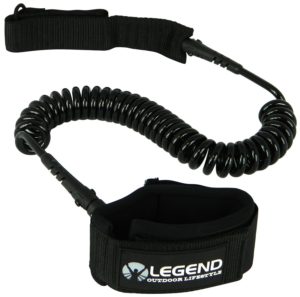The sun’s reflecting off the clear blue water, there is a cool breeze blowing, and you have a paddle board in your hand. The next thing that you, or anyone else, would wanna do is to get out on the water. But before you do that, there is one crucial detail that you are missing: something that could very well save your life in the water.
The SUP leash.
Small Thing Big Difference
The importance of the leash cannot be stressed enough. I can already hear some brave (but foolish) ones saying We don’t need one, that’s for pussies… Believe me, everyone should have a leash attached to their ankle or just below the knee.
I am not trying to be patronizing. The time it takes to attach yourself to the board will prevent accidents. What’s more, it could also prevent someone else from getting hurt.
There are too many tragic examples of accidents and deaths that could have been avoided with a SUP leash. Check out the story of Andres Pombo if you still think I’m exaggerating.
Why You Need A SUP Leash
Imagine you’re out on the water, with the sun above your head and the board beneath the feet. There is nothing to suggest that things could take a turn for the worse. And then it happens. A strong breeze blows straight at you. The next thing you know, the board is going in one direction and you’re in the water. You swim quickly, pushing towards the board. That’s when the second accident of the day happens. The board crashes into another paddle-boarder who falls into the water as well.
The above scenario can be completely avoided with a simple SUP leash. It takes no time to fasten the board to yourself. A simple step can avoid a major accident.
Three Reasons Why…
If the scenario did not work for you, I have listed the three incontestable reasons why a leash is an absolute must. Here they are:
- The board does not float away from you
The no.1 reason to have a leash – you will never be separated from the board. Especially, if you lose control of it, or take a tumble. A board can get away from you in no time if there’s a strong undercurrent.
- A safer experience
One can never predict the elements. You may start off with a gentle breeze or no breeze, and then encounter a strong gust or choppy waters down the river or lake. The leash ensures that you remain protected, no matter the weather or water conditions.
- Have more fun
Now, this may sound like a paradox, but with safety ensured on the SUP, you can have much more fun out on the water. If you’re in the mood for a bit of adventure and want to stray beyond the flat waters, the leash ensures that you can tackle challenging conditions without any fear. If you are a beginner, the leash can act as a positive mental reinforcement and boost your confidence.
Choose The Right Leash
So far, I have stressed on why you need a SUP leash. But there’s more than just tying yourself to the board. You also need to choose the right kind of leash, which is equally important.
There are three types to choose from. I will provide details of all three and also tell you which one may be the best for you. Here we go:
- The Straight
This is ideal for the more adventurous; read: ocean and river paddle-boarders. The straight leash will keep you attached to the board during turbulence as well. If you fall off the board, the leash provides a quick line of recovery without entangling in submerged objects.
- The Coiled
This leash works well in flatwater conditions. You can use it for a number of purposes that includes cruising and even racing. Since the coiled leash stays on top of the board, it does not cause any drag.
- The Breakaway
Also known as the Quick Release, this leash is a proven lifesaver in rough water conditions. The USP (unique safety point) is that you can break away from the board, should the leash get stuck in underwater objects and pull you down. The breakaway can be a coiled or a straight leash. If you paddle board in white water, ALWAYS wear a breakaway leash! It’s absolutely essential that you can break away if needed. Amie Russell is a tragic example of what can happen when you’re not able to release the leash in white water.
Expert Safety Tips
Now that you know how SUP leashes can save your life, let me give you a couple of safety tips:
- The leash should be a foot longer than the size of your board. This prevents any backlash that may occur with a shorter length.
- Never detach yourself from the board. This can cause a safety hazard to other paddle-boarders and surfers. The only exception is when the leash is entangled with underwater objects. Then you should break away from the board.
Stay Safe.
Toby
SupBoardGuide Editorial Team
Latest posts by SupBoardGuide Editorial Team (see all)
- Best Inflatable Paddle Boards (iSUPs), 2025 - July 3, 2025
- Best Cheap Inflatable Paddle Boards (2025) - March 26, 2025
- SeaGods Carta Marina CX Review - January 31, 2025










In moving water, yes, a quick release leash should be worn on a waist belt. However, in surf conditions, a waist belt can actually really hurt your back if your board gets tossed around in a wave. And not wearing a leash is never an option while surfing, as your board WILL hurt someone if it gets away from you – this is why surfers need to wear a straight ankle leash to keep themselves and others safe.